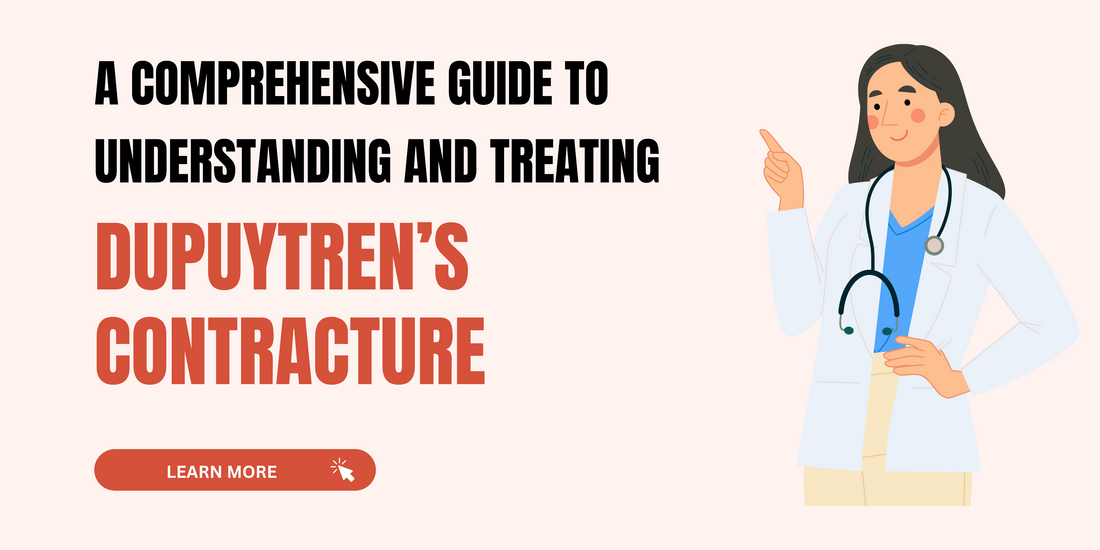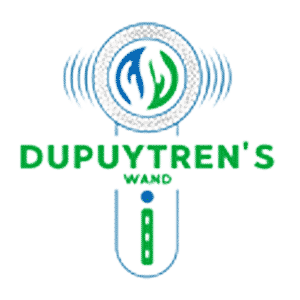
A Comprehensive Guide to Understanding and Treating "Dupuytren’s Contracture"
Share
A strange mass appears under your palm when you wake up one morning. Your initial symptom, without pain, causes you to dismiss its existence. A significant amount of time passes, followed by many months, until you discover your finger becomes stuck in an inward position when attempting to straighten it. Basic daily actions such as handshaking, glove application, and searching for items in a pocket have become harder to perform. If this sounds familiar, you might be experiencing Dupuytren's contracture, also known as "Viking's disease."
Dupuytren's contracture affects millions globally because it presents as a hand condition that progressively spreads while reducing an individual's quality of life. The good news? Treatment options expand continuously to provide patients with evolving procedures that give hope against this disabling condition.
What is Dupuytren's Contracture (Viking's Disease)?
Various historical records demonstrate that this condition emerged when Vikings lived during their demographic period. The ring finger and little finger frequently suffer from Dupuytren's contracture, but other fingers can also develop this condition.
A medical term received "Viking's disease", because it affected people from Northern Europe, primarily including individuals with Scandinavian backgrounds. Analysis of historical records shows that hand deformity affected people since the medieval period through Viking times.
Signs and Symptoms
The progression of Dupuytren's contracture typically follows a predictable pattern:
- Nodule formation: Small, firm lumps develop in the palm, often painless but sometimes tender.
- Cord development: These nodules may extend and form cords of tissue that stretch from the palm into the fingers.
- Contracture: Over time, these cords tighten, pulling the fingers toward the palm and restricting movement.
-
Functional limitations: As contractures worsen, everyday activities become increasingly difficult.
The initial manifestation of this condition presents as a small, unremarkable lump which patients may unintentionally ignore. The illness reaches an advanced state before individuals develop substantial finger contracture, making therapeutic interventions more difficult at this stage.
Understanding the Causes
While the exact cause of Dupuytren's contracture remains somewhat mysterious, several risk factors have been identified:
Genetic Factors
Medical experts have demonstrated that heredity plays a robust role in the development of Dupuytren's contracture. People carry a greater risk of developing Dupuytren's contracture when they have blood relatives who also have the condition. Multiple scientific studies have emphasized Dupuytren's genetic markers, which verify that the disease runs in families.
Environmental Triggers
Research suggests that certain environmental factors may trigger or accelerate the development of Dupuytren's contracture in genetically susceptible individuals:
- Manual labor: Repetitive hand trauma may contribute to symptom development.
- Smoking: Tobacco use has been linked to earlier onset and more severe disease progression.
- Alcohol consumption: Heavy drinking appears to increase the risk of developing the condition.
- Diabetes: Diabetic patients have a higher incidence of Dupuytren's contracture.
- Age: The condition typically appears after age 50, with risk increasing with age.
Dupuytren's Contracture Natural Treatment Options
Different natural treatment methods exist to control symptoms of Dupuytren's contracture and possibly delay its advancement, particularly during the initial stages.
Regular stretching exercises created for Dupuytren's contracture help patients maintain finger flexibility and possibly stop the condition from advancing. These exercises typically involve:
- Gentle finger extensions
- Tabletop stretches
- Massage techniques to soften nodules and cords
- Finger-specific stretching routines
With a specialist hand therapist, you can receive a treatment plan customized to measure your condition and the involved fingers.
Vitamin E and Supplements
Medical evidence about vitamin E supplements' benefits for patients remains weak despite positive reports from certain patients. Vitamin E's tissue-inflammation-fighting properties work alongside its antioxidant effects to support tissue functionality.
Other supplements that some patients have found helpful include:
- N-acetylcysteine (NAC): May help break down accumulated collagen
- Omega-3 fatty acids: Known for their anti-inflammatory properties
- Bromelain: An enzyme derived from pineapple that may help reduce inflammation
Users need to get healthcare provider approval for supplements because these products typically introduce little danger to your health although some people must avoid the usage of supplementation if they take other medications.
Topical Treatments
Various topical preparations have been developed specifically for Dupuytren's contracture:
- Magnesium oil: Some patients report reduced nodule size with regular application
- DMSO (dimethyl sulfoxide): May help other ingredients penetrate deeper into affected tissue
- Transdermal verapamil: A calcium channel blocker that may help soften Dupuytren's tissue
The topical application needs continuous use spanning numerous months to achieve noticeable outcomes.
Lifestyle Modifications
Simple lifestyle changes can complement other treatments:
- Avoiding trauma to the hands: Protective gloves during manual activities can help
- Reducing alcohol consumption: May slow disease progression
- Quitting smoking: Reduces a significant risk factor
- Warm water soaks: Can improve circulation and reduce stiffness
- Maintaining healthy blood sugar: Particularly important for diabetic patients
Ultrasound Therapy
Low-intensity ultrasound has shown promise in some small studies for managing Dupuytren's contracture. The sound waves may help break down the abnormal tissue formations and improve hand flexibility.
Medical Interventions: Beyond Natural Remedies
When natural treatments prove insufficient, several medical interventions are available, ranging from minimally invasive procedures to surgical options.
Needle Aponeurotomy
This minimally invasive procedure involves using a needle to perforate and break up the cords of tissue causing the contracture. Benefits include:
- Minimal recovery time
- Can be performed in an outpatient setting
- No large incisions
- Can be repeated if contractures recur
However, needle aponeurotomy has limitations, including a higher recurrence rate compared to more extensive surgical options.
Collagenase Injections
FDA-approved collagenase injections (Xiaflex) work by breaking down the collagen in the cords. The treatment protocol typically involves:
- Injection of the enzyme into the cord
- A follow-up visit 24-72 hours later to manipulate the finger and break the weakened cord
- Finger stretching exercises to maintain the improvement
These injections can be remarkably effective for appropriately selected patients, offering significant improvement without extensive surgery.
Radiation Therapy
Low-dose radiation therapy has shown potential for slowing the progression of early-stage Dupuytren's contracture. It's thought to work by reducing the activity of the cells responsible for producing the excessive collagen. This treatment is more commonly used in Europe than in North America.
Dupuytren's Contracture Surgery: When and Why
For advanced cases or when other treatments fail, surgical intervention may become necessary. Understanding the different surgical approaches can help patients make informed decisions.
Fasciotomy
This procedure involves cutting the thickened cords to allow finger extension. There are two main types:
- Percutaneous fasciotomy: A minimally invasive approach using a needle or small blade
- Open fasciotomy: Involves a larger incision to expose and cut the cord
Recovery typically takes several weeks, with physical therapy playing a crucial role in maintaining the improved range of motion.
Fasciectomy
More extensive than a fasciotomy, a fasciectomy involves removing the affected fascia (connective tissue) entirely. Variations include:
- Limited fasciectomy: Removes only the visibly affected tissue
- Radical fasciectomy: Removes a larger portion of the palmar fascia to reduce recurrence risk
While more invasive, fasciectomy typically provides longer-lasting results than fasciotomy, with lower recurrence rates.
Dermofasciectomy
For severe or recurrent cases, dermofasciectomy not only removes the affected fascia but also the overlying skin, which is replaced with a skin graft. This extensive procedure has the lowest recurrence rate but involves a longer recovery period.
Surgical Recovery and Rehabilitation
The success of Dupuytren's contracture surgery depends significantly on proper rehabilitation:
- Initial recovery: Typically involves wound care, pain management, and protecting the surgical site
- Early mobility: Gentle movement is often encouraged to prevent stiffness
- Scar management: Techniques like massage and silicone sheeting can minimize scarring
- Structured physical therapy: Customized exercises help regain strength and flexibility
- Night splinting: May be recommended to maintain finger extension
Complete recovery can take anywhere from 6 weeks to 6 months, depending on the surgical approach and individual factors.
Choosing the Right Treatment Path
With so many options available, how do you determine the best approach for your situation? Consider these factors:
- Disease stage: Early-stage Dupuytren's may respond well to natural treatments, while advanced contractures often require more aggressive intervention
- Functional impact: How significantly is the condition affecting your daily activities?
- Previous treatments: What approaches have you already tried, and what were the results?
- Personal preferences: Some patients prefer to avoid surgery if possible, while others want the most definitive solution
- Overall health: Your age, medical conditions, and medication use may influence treatment recommendations
A consultation with a hand specialist experienced in treating Dupuytren's contracture can provide personalized guidance based on your specific circumstances.
Living with Dupuytren's Contracture
As a chronic condition, Dupuytren's contracture requires ongoing management even after successful treatment. Patients should:
- Stay vigilant for signs of recurrence
- Continue prescribed exercises and stretches
- Protect hands from unnecessary trauma
- Address related conditions like diabetes
- Consider joining support groups to connect with others facing similar challenges
Many patients successfully manage Dupuytren's contracture through a combination of treatments, allowing them to maintain hand function and quality of life.
About DupuytrenCure
At DupuytrenCure.com, we understand the challenges of living with Dupuytren's contracture. Our mission is to provide comprehensive, evidence-based information about this condition and its various treatment options, from natural remedies to surgical interventions.
Our team of specialists brings together expertise in hand surgery, physical therapy, and complementary medicine to offer a holistic approach to managing Viking's disease. Through our website, we provide:
- Educational resources on Dupuytren's contracture
- Detailed descriptions of treatment options
- Step-by-step exercise programs
- Success stories from patients who have overcome the condition
- A community forum for sharing experiences and support
Whether you're newly diagnosed or have been battling Dupuytren's contracture for years, DupuytrenCure.com is your trusted resource for navigating this challenging condition. Our goal is to help you regain control of your hand function and improve your quality of life.
Visit us today at DupuytrenCure.com to learn more about our approach and discover how we can help you break free from the Viking's grip.
Conclusion
Dupuytren's contracture may be an ancient condition, but modern understanding and treatment options continue to evolve. From traditional approaches like surgery to emerging natural therapies, patients today have more choices than ever before.
Remember that early intervention often leads to better outcomes, so if you notice suspicious nodules or finger contractures, don't wait to seek professional advice. With the right approach, many patients can maintain or regain hand function and continue enjoying their daily activities without limitation.
By staying informed and working closely with healthcare providers specializing in hand conditions, you can develop an effective strategy for managing Dupuytren's contracture and preserving your hand function for years to come.
